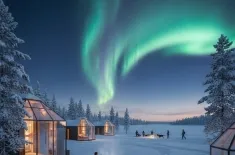Explore regenerative tourism and climate-positive resort experiences.
The global tourism industry, a powerful economic engine, has reached a critical inflection point. For decades, the focus has been on minimizing negative impacts—a concept known as sustainable tourism. While essential, this approach is no longer sufficient to address the scale of the climate crisis, biodiversity loss, and social inequality. A profound shift is underway, moving from simply "doing less harm" to embracing **regenerative tourism**—a philosophy that actively seeks to leave people, places, and ecosystems better than they were found. This movement is intrinsically linked to the rise of **climate-positive resort** and accommodation models, setting a new, ambitious benchmark for travel in the 21st century.
The Great Shift: From Sustainable to Regenerative
The core difference between sustainability and regeneration is one of impact magnitude and intent.
Sustainable Tourism: The Neutral Goal
Sustainable tourism, as defined by organizations like the UNWTO, aims to manage resources in a way that economic, social, and environmental needs can be fulfilled while maintaining cultural integrity and ecological processes. The intention is to achieve a state of net-zero negative impact.
- Focus: Mitigation and preservation.
- Action: Reducing energy consumption, minimizing waste, banning single-use plastics, and conserving existing cultural sites.
- Mindset: "Take only pictures, leave only footprints." The goal is balance, or the maintenance of the status quo.
Regenerative Tourism: The Net-Positive Imperative
**Regenerative tourism** operates from a systems-thinking perspective, viewing the destination—the natural environment, the local culture, and the community—as a living, interconnected system. Its aim is not just to preserve, but to actively improve, restore, and revitalize these systems.
- Focus: Restoration, renewal, and creation of net-positive value.
- Action: Engaging visitors in reforestation, coral reef restoration, **community-owned lodges**, and supporting circular local economies.
- Mindset: "How can we leave this place and its people better than we found them?" The goal is abundance and flourishing.
This paradigm shift acknowledges that simply reducing damage is no longer enough to repair centuries of environmental degradation and cultural exploitation. Regeneration demands that tourism be a force for good, creating a measurable, lasting positive legacy.
The Rise of Climate-Positive Stays and Carbon-Negative Travel
The climate emergency is the most urgent challenge facing the travel sector. While sustainable efforts focused on reducing a resort's carbon footprint, the regenerative model introduces the concept of **climate-positive resort** and **carbon-negative travel**.
A typical hotel might invest in solar panels to reduce its energy use. A **climate-positive resort** goes further: it commits to removing more carbon dioxide from the atmosphere than it emits across its entire operation, including guests' stays and supply chains.
Achieving Carbon-Negative Status
Achieving a **carbon-negative travel** footprint is a monumental, yet vital, undertaking. It is a three-pronged strategy:
- Radical Decarbonization: This involves switching to 100% renewable energy (solar, wind, geothermal), implementing extreme efficiency measures, and eliminating fossil fuels from transportation fleets and operations.
- On-Site and Local Carbon Sequestration: The resort doesn't just offset; it sequesters. This means investing in and participating in nature-based solutions on their land and in the local community. Examples include:
- Regenerative Agriculture: Shifting farming practices to improve soil health, allowing the land to draw down and store significant amounts of atmospheric carbon.
- Reforestation and Blue Carbon Projects: Planting native trees, restoring coastal mangroves, or rehabilitating seagrass meadows, all of which are incredibly effective **biodiversity-offset** mechanisms that also absorb carbon.
- Holistic Supply Chain Management: Demanding that all suppliers—from food producers to linen providers—adhere to equally rigorous low-carbon standards, effectively creating a circular tourism economy.
Beyond Offsetting: True Regenerative Investment
Traditional carbon offsetting—often planting trees in distant locations—is frequently criticized as a "license to pollute." **Regenerative tourism** demands a more direct, accountable approach. Instead of simply buying credits, the funds are invested in local, verifiable projects that serve both climate and community needs, such as:
- Community-Owned Renewable Infrastructure: Funding solar installations for local schools or hospitals, which not only reduces emissions but provides social benefit.
- Water and Waste Systems: Developing closed-loop water systems and converting organic waste into biochar or compost to enrich local soil.
Empowering Communities: The Social Pillar of Regeneration
The social and cultural impact of tourism is just as crucial as the environmental. A regenerative approach dismantles the extractive model of mass tourism, which often sees local culture commodified and wealth leaking out of the host country.
Community-Owned Lodges and Economic Empowerment
Regeneration centers local empowerment. **Community-owned lodges** and homestays, where the ownership and decision-making power rests with the local or indigenous population, are the gold standard.
- Equity and Fair Wages: Ensuring that the financial benefits of tourism circulate locally, providing equitable wages, education, and healthcare access.
- Preserving Cultural Heritage: Experiences are not "staged" for tourists but are genuine, mutually respectful cultural exchanges. Visitors learn about traditions, craftsmanship, and ancestral knowledge from the community itself, which provides a financial incentive for the preservation of those traditions.
Visitor as Participant, Not Spectator
The regenerative experience requires a transformation of the traveler's mindset. Guests are not passive consumers of a beautiful destination; they are active participants in its flourishing.
- Hands-on Conservation: Travelers may be invited to join a **biodiversity-offset** project, such as monitoring sea turtle nesting sites, helping a local farmer with regenerative agriculture practices, or documenting traditional medicinal plants.
- Deep Connection: This level of engagement fosters a profound sense of connection and reciprocity, transforming a simple vacation into a purposeful, lasting memory.
Eco-Conscious Luxury: Redefining the High-End Experience
The concept of luxury is being radically redefined. The modern, discerning traveler no longer sees **eco-conscious luxury** as a compromise, but as the highest form of travel. True luxury is no longer about excess; it’s about impact and authenticity.
- Subtractive Design: Luxury resorts now pride themselves on how seamlessly they disappear into the natural landscape, using native materials, traditional building techniques, and design that respects the ecology of the site.
- High-End Experiences with High-Impact Purpose: The luxury experience is elevated by its regenerative purpose. Imagine a Michelin-starred meal sourced entirely from the resort's regenerative agriculture farm, or a guided wildlife safari led by an indigenous conservationist whose salary directly funds local ecosystem protection.
This shift proves that environmental and social responsibility doesn't detract from quality; it enhances it, offering an authentic, meaningful experience that generic, high-carbon models can never provide.
The Future is Regenerative
The journey towards fully **regenerative tourism** is not a destination but a continuous process. It is a call to action for every stakeholder:
- For Destinations: To recognize their unique natural and cultural assets as living systems and to place the well-being of their communities and ecosystems above simple visitor numbers.
- For Businesses: To adopt a regenerative tourism business model that fundamentally redefines success from profit maximization to holistic value creation for all stakeholders.
- For Travelers: To choose **carbon-negative travel** options, seek out **community-owned lodges**, and pay the "true cost" of their trip, knowing that their investment actively contributes to the restoration of the planet.
Ultimately, regenerative tourism is about healing—healing the land, healing the climate, healing communities, and healing our relationship with the places we visit. It allows travel to move from a guilt-ridden luxury to a truly **climate-positive** force, ensuring the world’s most beautiful destinations can flourish for generations to come.



































